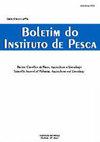FEEDING HABITS OF Lutjanus synagris (TELEOSTEI: LUTJANIDAE) IN THE AMAZON COAST OF THE NORTHEAST REGION OF BRAZIL
IF 0.6
4区 农林科学
Q4 FISHERIES
引用次数: 2
Abstract
The feeding habit of lane snapper Lutjanus synagris was analyzed qualitatively and quantitatively, related to seasonality, its ontogenetic development, and the relationship between food and biotic and abiotic conditions on the Amazon Coast of Maranhão, between June 2018 and May 2019. Numerical, gravimetric, and ecological index methods were used to show the relative importance or preference of a category or food item in the diet. The food composition was studied related to the sex, size of the predator and seasonality. Of 359 stomachs sampled, 54 were empty due to regurgitation and presented a vacuity coefficient (Cv%) of 15.04%. In the analysis of diets between the sexes, it was possible to identify a greater participation of fish (30.43%) and Crabs (26.10%) for females, Shrimp (36.23%) and Organic Matter Not Identified (OMNI) (18.84%) in males. The diet showed spatial differences in length distributions. The analysis of stomach contents showed the presence synthetic materials (mesoplastics ranging from 5.0 mm to 2.5 cm) in 5.52% of the samples. The main food items found were from the Brachyura and Caridea species. The results clearly demonstrate that lane snapper prefers benthic prey, presenting a carnivorous and generalist-opportunistic habit. Its diet is also composed of demersal-pelagic species, such as Cephalopods and Teleost fish.巴西东北地区亚马逊河沿岸绿背蝽的摄食习性
2018年6月至2019年5月,对maranh亚马孙河沿岸梭鲈(lujanus synagris)的食性、季节性、个体发育、食物与生物和非生物条件的关系进行了定性和定量分析。数值法、重量法和生态指数法被用来显示饮食中一个类别或食物项目的相对重要性或偏好。研究了食物组成与捕食者的性别、体型和季节的关系。在359个胃样本中,54个胃因反流而空,其真空系数(Cv%)为15.04%。在两性之间的饮食分析中,可以确定雌性中鱼类(30.43%)和螃蟹(26.10%)的比例更高,雄性中虾(36.23%)和未识别有机物(OMNI)(18.84%)的比例更高。日粮长度分布存在空间差异。胃内容物分析显示,5.52%的样品中存在合成材料(5.0 mm ~ 2.5 cm的中塑料)。发现的主要食物来自短尾目和栉齿目。结果清楚地表明,鲷鱼偏爱底栖动物,表现出食肉性和多方位机会主义的习性。它的饮食也包括底栖-远洋物种,如头足类和硬骨鱼。
本文章由计算机程序翻译,如有差异,请以英文原文为准。
求助全文
约1分钟内获得全文
求助全文
来源期刊

Boletim do Instituto de Pesca
FISHERIES-ZOOLOGY
CiteScore
0.80
自引率
0.00%
发文量
24
审稿时长
>12 weeks
期刊介绍:
To publish original articles of research and short communications in the following áreas: Fisheries, Aquaculture, Zootechnology, Limnology, Oceanography, Biology and Pathology of aquatic organisms. The publication depends on the approval of the Editorial Board, based on the peer review.
 求助内容:
求助内容: 应助结果提醒方式:
应助结果提醒方式:


